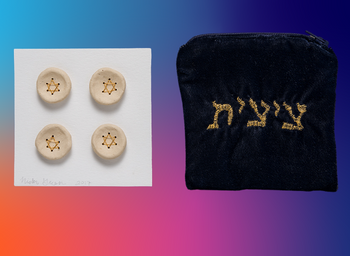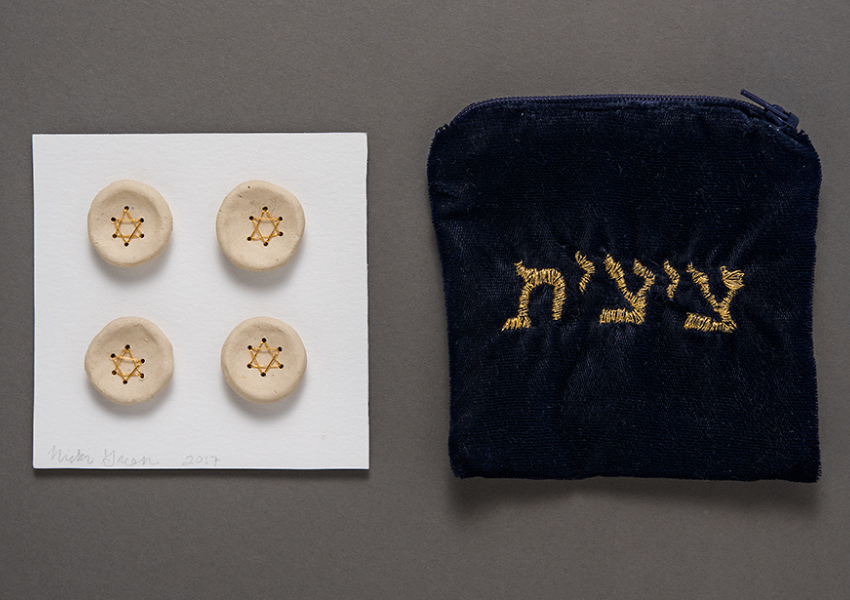Ritual Buttons: New Art for Ancient Customs
Published Jan 17, 2023

Ritual Buttons: New Art for Ancient Customs

Nicki Green is a transdisciplinary artist working primarily in clay. Her sculptures, ritual objects, and various flat works explore topics of historical preservation, conceptual ornamentation, and aesthetics of otherness. In response to the unique features of the prayer shawls and ritual fringes from the Karaite community in Cairo, Nicki created Ritual Buttons: a set comprising new buttons to attach fringes to a prayer shawl, and an embroidered bag to store said fringes. This new work was displayed alongside traditional Karaite ritual artifacts in a 2018 exhibition, The Karaite Canon. The bag that Nicki created – a new ritual object steeped in Jewish tradition and close reading of the Hebrew Bible – is shaped after the bag for the prayer shawl she had used years before, in celebration of her (then male-identified) Bar Mitzvah.
In an artist statement that we developed together to accompany the work, Green wrote: “So much of Judaism across regions and backgrounds revolves around distinction, havdalah, the identifying of a Jewishness that is separate, distinct from other religions, and religiosity as distinct from secular lives. In my conversations with curator Francesco Spagnolo, we thought about the buttons and loops Karaite Jews use to attach fringes to their prayer shawls as a way of making their ritual practices distinct from other Jewish ones. Why, then, would the Karaites use a practice that suggests fluidity? Is there a functional purpose beyond distinction? […] The project seeks to identify that even in the most direct and fundamental interpretation of text, one is always adapting and filtering law and practice through the lens of one’s body, offering a place for expansiveness and innovation.”
In my tenure as Curator of The Magnes Collection of Jewish Art and Life at the University of California, Berkeley, I strive to engage scholars – including faculty, as well as graduate and undergraduate students – with one of the largest Jewish museum collections in the world. In 2017, while I was preparing a new exhibition focusing on a collection of manuscripts and ritual objects collected in 1971 from the Karaite community in Cairo, Egypt, I came across a unique feature in Karaite tallitot (prayer shawls). In normative (Rabbinic) Judaism, prayer shawls present a chance to add tzitzit (ritual fringes) to the corner of a garment, thus following a biblical commandment (found in Numbers and Deuteronomy). By using buttons and/or loops, Karaite prayer shawls allow their wearers to add the ritual fringes to them, rather than just wear them as part of the garment, thus literally fulfilling the commandment: “Speak unto the children of Israel, and bid them that they make them throughout their generations fringes in the corners of their garments…” (Num 15:38). I thought that this divergence may bring new artistic insight, and I thus invited artist Nicki Green, then a Graduate Student in UC Berkeley’s Department of Art Practice, to examine the original artifacts with me, and to create an artistic response to them that would be included in my exhibition (The Karaite Canon, 2018).
Above:
Nicki Green
Ritual Buttons
United States, 2018
Ceramic, metallic thread, cotton velvet, metal zipper, and card stock
The Magnes Collection of Jewish Art and Life, University of California, Berkeley, gift of the artist 2018.12
Francesco Spagnolo is the Curator of The Magnes Collection of Jewish Art and Life and an Associate Adjunct Professor in the Department of Music at the University of California, Berkeley. A multidisciplinary scholar focusing on Jewish studies, music, and digital media, he intersects textual, visual, and musical cultur...
Reflections
Law/Ritual/Tradition
While Jewish texts and religious authorities tend to focus on laws and their intellectual interpretations, Jewish rituals offer an array of possible embodied, and often divergent, interpretations of the laws themselves. What is tradition, then? The repetition of established customs or a creative engagement that may, in the end, betray them?
Queering Text?
Recent (and less) recent efforts to expand the canon of Jewish thought have focused on gender identities and expansive readings of traditional rabbinic texts, from the Bible to the Talmud. Do you find that this practice is radically innovative or, in turn, grounded on an intellectual tradition that for millennia has favored open and divergent ideas?
Want more?
Get curated JewishArts.org content in your inbox


